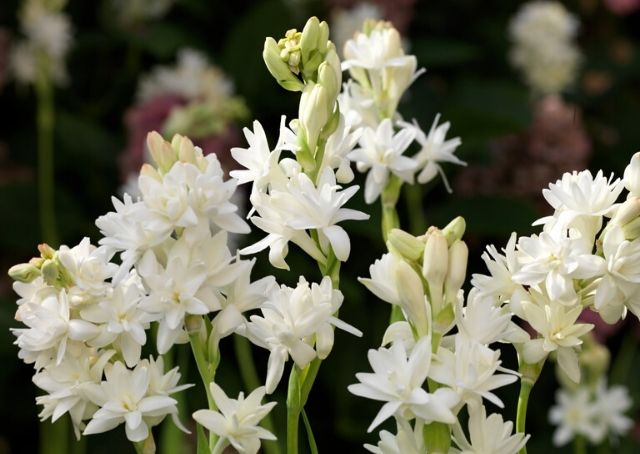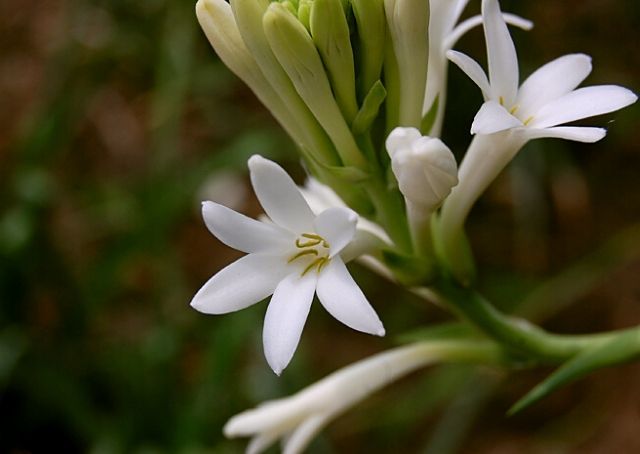Tuberose: 3 things you don’t know about the white flower of seduction
From the polyanthes tuberosa, a plant native to Mexico, a flower is born that is highly appreciated by the world’s perfumery. Let’s discover together the history and characteristics of this sensual “creature of the night”.
1) Tuberose: the history of the flower from the Aztecs to today
Originally from South America, tuberose is a plant belonging to the Amaryllidaceae family with a thousand-year history behind it. The pre-Columbian peoples began to cultivate it for its healing properties with the aim of easing the fatigue of travellers, but also for its intense perfume with which they flavored the hot chocolate drinks of which they were greedy.
The main users of tuberose were the Aztecs, who baptized it omixochitl, that is, “bone flower”, probably due to its whiteness. It was only during the sixteenth century that the Spaniards together with a French missionary brought the plant to Europe: here the white and scented flower began to be part of the famous lunar gardens, places full of pale silvery buds that began to give off their fragrance intense only after sunset. These nocturnal havens were very popular among Victorian-era ladies as they highlighted the candid pallor of their complexion more.
The tuberose flower became so famous that it earned mentions in some of the most important literary works of the 19th century. The Irishman Thomas Moore in his poem Lalla Rookh defined him “the Mistress of the Night! She who, like a bride, perfumed and luminous, comes out when the sun sets”, while Percy Shelley in The Sensitive Plant described it as “the sweetest flower for the scent it gives off”. Nowadays, tuberose continues to be appreciated in the world of fragrances for its flowers with an intense and sweet scent, and is widely cultivated in Morocco, France, South Africa, the Comoros Islands, Hawaii, the Antilles, India and China.
2) The characteristics of tuberose: the white flower with hypnotic and aphrodisiac power

Tuberose flowers at night when the colors are not visible. Therefore, to attract pollinating insects, she and the other white flowers (including jasmine, orange blossom, magnolia) had to resort to a curious trick: a scent so strong as to be perceived from meters and meters away.
Defined as a “perfumery harlot” for its fragrance so intense as to be considered almost narcotic, tuberose was categorically forbidden to European girls during the Renaissance. The fear was that these flowers of sin could inspire illicit thoughts in them, leading them to a spontaneous orgasm and total perdition. The same prohibition was also adopted in India – where tuberose, ki rani, means “courtesan of the night” – as it was thought that their perfume could make one fall into a spiral of emotionality that was difficult to escape.
In fact, for Ayurvedic medicine, tuberose stimulates the right side of the brain, increasing the ability to experience feelings and amplifying creativity. Recent studies, among other things, have confirmed the aphrodisiac power of its essential oil, used above all in aromatherapy to reduce stress and tension and relax the brain, muscles and nerves. Furthermore, the tuberose essential oil seems to be able to improve blood circulation, with a beneficial effect on the whole body.
3) Tuberose perfume: what are the characteristics and where to find it
In the past, tuberose absolute was extracted only in southern France using the enfleurage method: it is a process for cold treating all delicate flowers such as rose, jasmine, violet and tuberose itself. The technique is based on a principle dating back to medieval alchemy according to which like dissolves like: given that essential oil is a lipophilic substance, the solvent used for enfleurage was in ancient times a solid fat, usually of animal origin such as pig or ox.
Nowadays vegetable fats such as benzoin are used, and the odorous concentrate that results from the elimination of solvents is precisely defined as absolute. The perfumed sap obtained from tuberose has an intense floral scent, almost narcotic, which tends to be indelibly fixed in the olfactory memory of those who come into contact with it. The sugary notes together with the camphorated ones make the tuberose perfume incredibly feminine and sensual: a great diva fragrance, with magnetic power.
For you who dare to try its erotic and carnal sweetness, we at Carthusia have created Tuberose, a soliflore that won’t let you go unnoticed. In Parfum format (50 ml) or Eau de Parfum (50 or 100 ml), the voluptuous and intoxicating charge of Tuberose will amaze you and anyone who passes by you. You can discover the fragrance in all of our Carthusia stores, but if you prefer, you can think of an online purchase on our Carthusia e-shop: in a few days, the chosen format will arrive directly at your home.

